Pests and Diseases
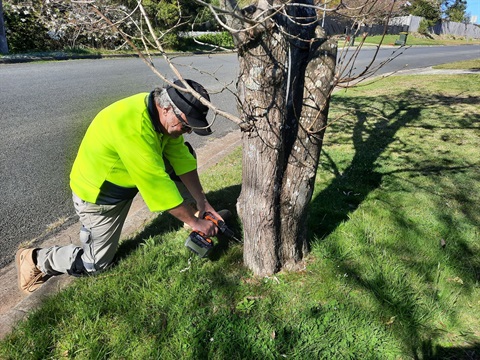
Wingecarribee Shire Council has numerous pests and disease affecting the local area. Both public and private trees are being affected by pests and diseases where some have been here for a while and others that are new and emerging.
To minimise the risk of spreading tree pests and diseases, limit transportation of infected material from the property unless it's covered and transported appropriately.
Whilst we are unable to list all pests and diseases affecting the trees and vegetation of our area.
The following guide has been created by Council's tree team based on community interest.
If you notice pests or diseases on Council trees, please let us know via the Request a Service page below. For more information about pests and diseases, please contact Council's Shire Presentation trees management team at mail@wsc.nsw.gov.au.
Request a Service
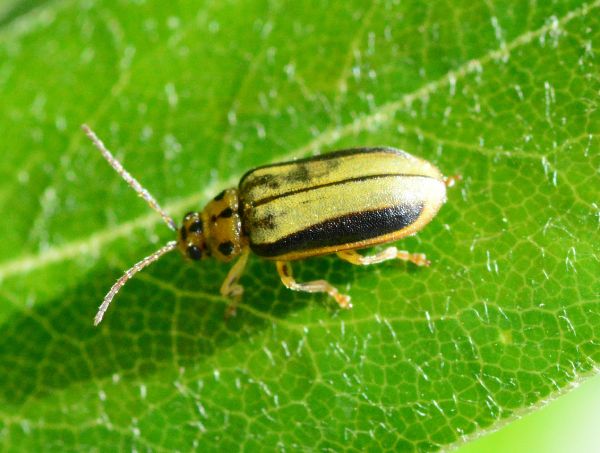 Elm leaf beetle.
Elm leaf beetle.
Elm Leaf Beetle
The Elm Leaf Beetle was first identified in Victoria in 1989 and in the years since they have moved interstate to Tasmania and New South Wales.
In 2013 they were found in neighbouring Goulburn and in 2018 Council detected the first evidence that the beetle had made its way to the Highlands.
The Elm Leaf Beetle (Xanthogaleruca luteola) is a native insect of Europe favouring a variety of elm trees. Since first identified in Australia the beetle has spread at a rate of approximately 25 km per year.
Once established in a host tree the beetle and larvae emerge from winter hibernation to feed on young and emerging leaves. Symptoms of Elm Leaf Beetle attack include ‘shot-hole’ or ‘scatter gun’ damage to leaves.
Heavy infestations of Elm Leaf Beetle can completely strip an elm tree of all its leaves.
The tree will usually send out new leaves the following year but if this happens for repeated seasons, the growth of the tree will be hindered and eventually it can die.
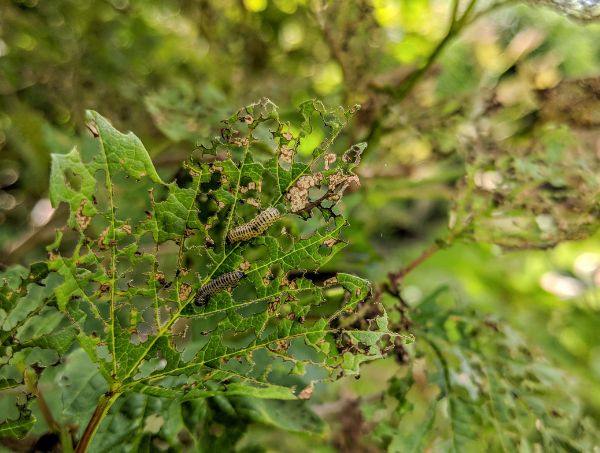 Elm leaf beetle larvae leaf damage.
Elm leaf beetle larvae leaf damage.
Identification of Elm Leaf Beetle and Larvae
Adult beetle:
About 6 mm long, yellowish to olive green with a black stripe along each side of the back.
Larvae:
About 12 mm long, green to yellow, black head and two black stripes on the back.
Pupae:
About 6 mm long and bright orange-yellow.
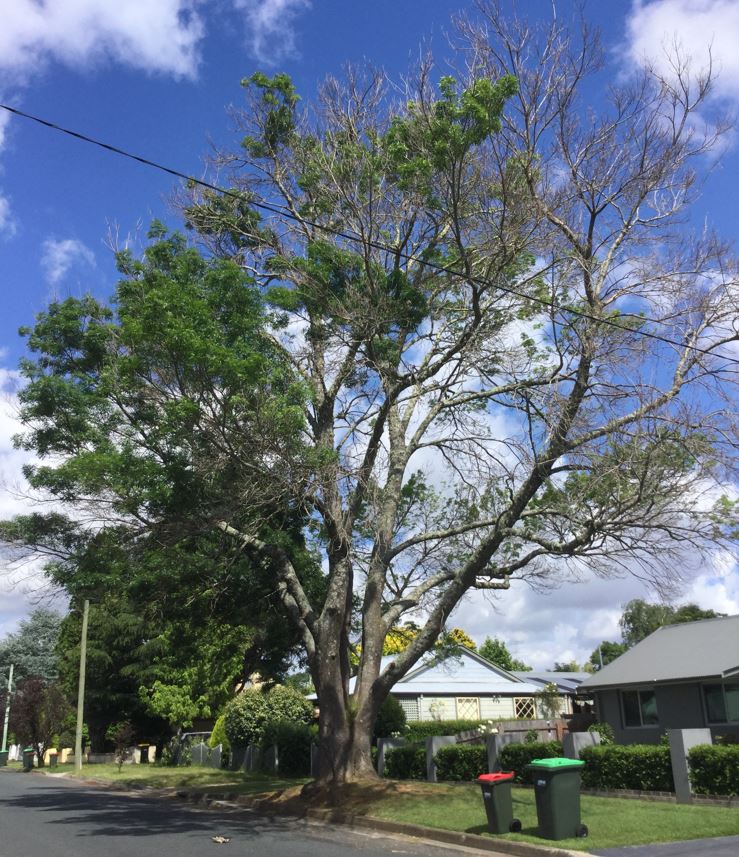 Ash dieback on a tree at Mittagong.
Ash dieback on a tree at Mittagong.
Ash Dieback
A number of Claret Ash trees (Fraxinus raywoodii) of the Southern Highlands have been identified as suffering from a fungal plant pathogen called Diplodia mutila.
Diplodia mutila is a fungal plant pathogen that has been reported on Ash trees in association with cankers.
Severe cankers can girdle stems and branches causing defoliation and death.
Dieback takes several seasons to slowly kill this species of ash tree.
The older the tree, the larger the trunk, the more likely there will be dieback in the tree.
Management of the disease involves reducing plant stress as well as removal of infected plant parts, where practical.
All tools and equipment must be disinfected after use with 70 per cent methylated spirits or diluted household bleach.
Progression of Ash Dieback at Moss Vale 2017-2018
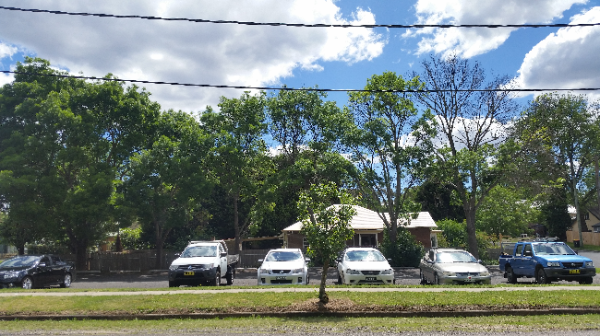 Ash dieback at Moss Vale tennis court car park 2017.
Ash dieback at Moss Vale tennis court car park 2017.
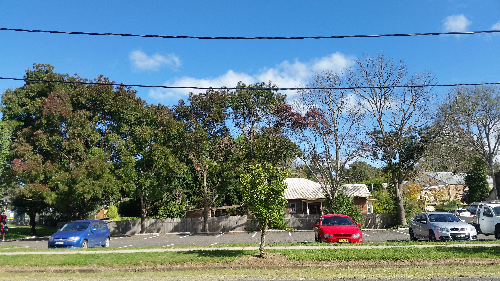 Progression of ash dieback at Moss Vale tennis court car park by 2018.
Progression of ash dieback at Moss Vale tennis court car park by 2018.
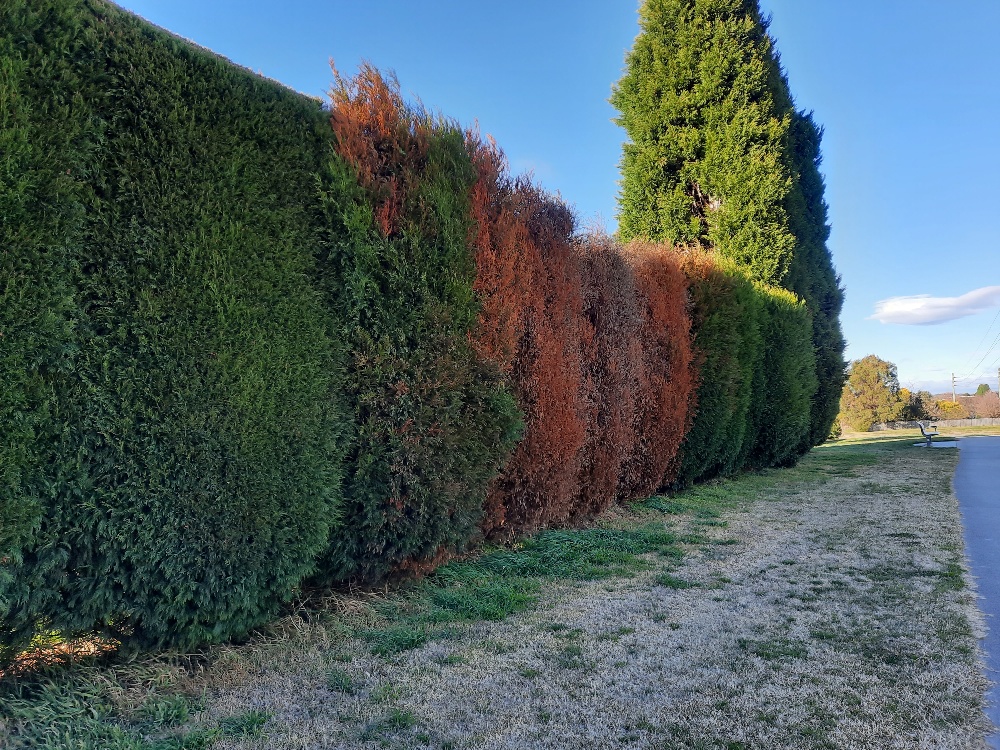 Hedge affected by Cypress Decline at Bowral.
Hedge affected by Cypress Decline at Bowral.
Cypress Decline
A large number of dead and dying Cypress trees have been observed in Wingecarribee Shire. There are a variety of contributory factors resulting in the decline of Cypress trees.
Long extended drought conditions, waterlogging with humid conditions as well as various fungal pathogens.
Hot, humid weather, drought and insects such as bark beetles can speed up the decline of trees infected with Cypress canker because of splitting bark and poor wound responses from the tree.
A whole row of trees might not all be infected at once. Trees in a row may show symptoms at the same time or the disease may appear to move along the row.
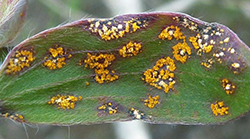 Myrtle rust on paperbark leaf (NSW DPI).
Myrtle rust on paperbark leaf (NSW DPI).
Myrtle Rust
Myrtle rust (Puccinia psidii) is a fungal disease which infects plants in the Myrtaceae family. Common Australian Myrtaceae species include eucalyptus, willow myrtle, turpentine, bottlebrush, paperbark, tea tree and lilly pilly.
It is not known to locally occur however Council recommends residents to stay vigilant. If positive identification occurs, contact Council for further information.
Myrtle rust is a fungal disease which targets fresh actively growing leaves. Severity of infection and symptoms vary with different host species.
Generally myrtle rust starts as small purple spots on leaves. Bright yellow spores form in pustules within these purple spots. Pustules fade to dull yellow and then grey as the infection ages. In severe infections, spots enlarge and merge, often causing leaf distortion.
Heavy infection can result in the death of soft plant material. Whole plant death may occur in highly susceptible hosts.
Black Sooty Mould
The presence of sooty mould fungi usually indicates that a plant has become infected by a sap-sucking insect. Sooty moulds do not attack the plant directly, but their growth is unsightly and can reduce plant vigour by preventing photosynthesis.
In Wingecarribee, the species of trees most susceptible to black sooty mould are Willows, Photinias and Ash trees.
Sooty moulds consist of a large number of different fungi, producing dark growth and spores. Commonly found within sooty mould growth are species of Cladosporium and Alternaria, but there are many others. They grow on sugar-rich honeydew produced by sap-sucking insects as a result of their feeding activities, or occasionally on sugary exudates produced by the plant itself.
To minimise the risk of spreading tree diseases, don't move infected material from the property.
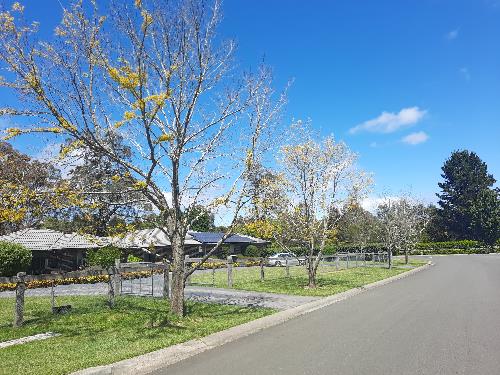 Robinia tree death at Moss Vale.
Robinia tree death at Moss Vale.
Robinia Tree Decline
Council is currently aware of sudden decline and death of Robinia trees (Golden Robinia - Robinia pseudoacacia 'Frisia') throughout the Southern Highlands and now reported in greater Sydney area.
Investigations and testing are underway in conjunction with NSW Department of Primary Industries (DPI).
Once the results are received following the investigations Council will update the information on this page.